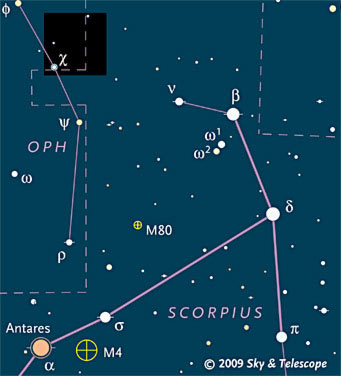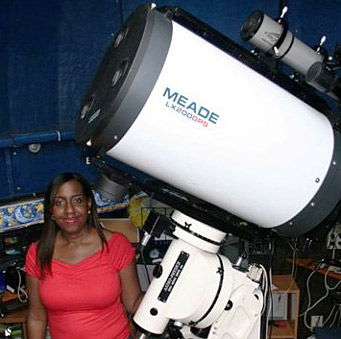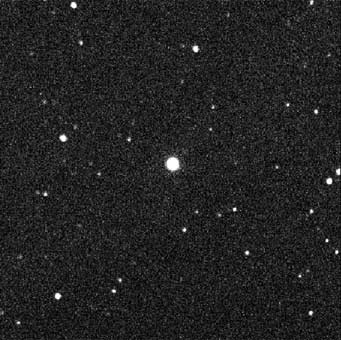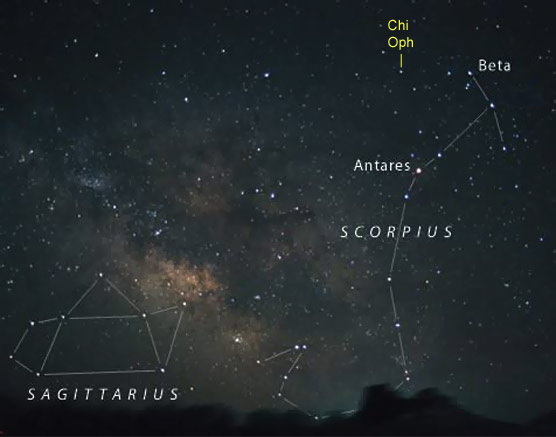
Scorpius is up before the first light of dawn at the end of January and in February. On the chart above, the black square shows the area of the closeup comparison-star chart below. Click on the chart for a larger, more printable view.
Sky & Telescope diagram
Update, February 5:
As of this morning U Sco was down to about magnitude 12.9. It has declined an average of 0.6 magnitude per day — faster at first, a little less rapidly now. More changes in the fading rate are expected.
In the last few days the first X-ray emission was detected by NASA's Swift satellite. No one knows why novae wait until they've faded substantially before they turn on in X-rays.
Less than a day ago U Sco also started the "flickering" characteristic of a fading nova; it's brightening and fading by about 0.2 magnitude over the course of an hour. This indicates that the hot white dwarf star has again begun accreting matter from its normal-star companion, as was happening before the outburst; an accretion disk around the white dwarf has evidently been re-established.
Now that the debris shell is expanding and thinning, the normal star's total eclipses of the white dwarf and the accretion disk should also again be visible.
Update, February 1:
As of this morning North American time, four days after its eruption, U Sco had dropped to 11th magnitude, consistent with its very fast declines in previous outbursts.
Observations continue worldwide and from space. Super-soft X-ray emission is expected to show up soon. As the star fades further in coming days and weeks, CCD-equipped amateurs should be able to start recording the expected eclipses of the newly heated white dwarf star by its larger, less-hot companion. Unlike many novae and recurrent novae, the U Scorpii binary is (luckily for detailed studies) a totally-eclipsing pair.
No additional pre-discovery sightings were reported. The star's rapid rise to peak brightness was completely missed. Apparently the last pre-discovery measurement was the one by Barbara Harris 24 hours before her discovery of the outburst. At that time, the star was still simmering dimly at its normal minimum.
Original story, January 28, 2010:
One year ago, Bradley Schaefer predicted that the recurrent nova U Scorpii was due to explode again. Now it's happened.
On Thursday morning, January 28th, amateur variable-star observers Barbara G. Harris and Shawn Dvorak in central Florida independently notified the American Association of Variable Star Observers (AAVSO) that U Sco had leapt to magnitude 7.9. Just 24 hours earlier, Harris had imaged it still in its quiescent state at 18th magnitude, about where it has been since its last eruption in 1999.
Schaefer made his prediction based on a thorough search through old photographic sky-patrol plates since 1900. He found three eruptions that had not been known previously and felt confident that he had a good handle on all of them. They come about every 10 ± 2 years, he found. So another seemed due.

Comparison-star magnitudes (courtesy AAVSO) are given for stars around U Scorpii with decimal points omitted. Click on the chart for a larger, more printable version. And click here for a more detailed AAVSO comparison chart for when U Sco becomes too faint for this one.
Sky & Telescope diagram
A lot of astronomers, professional and amateur, have been waiting. Observatory schedules are now being preempted, and astronomy satellites are being repointed. Schaefer has been hoping that with his advance warning, this will be the more thoroughly studied nova explosion ever.
Where to look
U Sco is located about 9° north of Antares, currently moderately well up in the southeastern sky just before the first light of dawn. The farther south you are the better, but even from as far north as latitude 45° (Oregon, Montreal, Milan), U Sco is at least 20° above your horizon before morning twilight begins. To find when morning twilight begins at your site, you can put your location into our online almanac. (Make sure the Daylight Saving Time box is unchecked).

Co-discoverer Barbara Harris.
Mike Simondson photo
U Sco both rises and fades fast. In previous outbursts, it has dropped by 2 magnitude in the first day and a half.
Here's the AAVSO's U Sco Campaign page.
Here are recent AAVSO magnitude estimates.
This is from an announcement just put out by the AAVSO:
"The two astronomers, Dr. Barbara Harris, MD, of New Smyrna Beach, and Shawn Dvorak of Clermont, were active participants in a global research campaign to monitor activity of U Scorpii. Both Harris and Dvorak had been conducting long-term monitoring as part of a campaign run by the AAVSO. This campaign, organized by Dr. Bradley Schaefer (Louisiana State University), involved professional and amateur observers from around the world monitoring this star every night.

Harris's discovery image of U Sco in outburst, taken at 10:31 UT on the morning of January 28, 2010. This frame is 12 arcminutes wide. North is up.
Barbara Harris
"Harris was first to detect the outburst shortly before 6 a.m. local time, with Dvorak's independent detection arriving shortly afterwards. The two near-simultaneous observations provided all the proof required to alert observers and observatories around the world and in space that U Sco's outburst had finally occurred. Within an hour, Schaefer set in motion the global network of observatories, and by the end of the morning, two X-ray satellites (the Rossi X-Ray Timing Observatory and the INTEGRAL satellite) had already made observations.
"Over the next several months, astronomers will be monitoring the progress of this outburst at nearly all wavelengths from radio waves to X-rays, using a number of ground-based telescopes and spaceborne observatories."

Just before dawn begins to break, Scorpius and Sagittarius are rising in the southeast for skywatchers at mid-northern latitudes (though they're not yet quite this high). Chi (χ) Ophiuchi, marked here, is the brightest star on the comparison-star chart above.
Jimmy Westlake photo
.

At its last eruption in February 1999, U Sco briefly reached 8th magnitude and faded rapidly in the following days. Green dots are visual magnitudes, blue dots are blue magnitudes. Large dots are photoelectric measurements, small dots are visual estimates.
Bradley Schaefer
 1
1
Comments
Graham.W. Wolf
February 7, 2010 at 4:18 pm
The U Sco outburst was seen here in New Zealand from Lower Hutt, a day or two after the official discovery (thanks to quick electronic notification, that wasn't availaable when I worked at the Carter National Observatory in the 80's and 90's). At ~ Mv 9, U Sco it was just conspicuous in 10 X 90 binoculars, considering some lunar pollution nearby. The Star Chi Sco made a good aiming point, and in the 18cm f5 Newtonian at 30x and 80 arcmin FOV, I was able to quickly confirm the target. Due to contrast stretching, U Sco was more visually conspicuous at High power. Now that it's faded well down ~ Mv 14 (pluto brightness), I consider myself priviledged to have had a box seat for the event at all. Thanks to S & T for the pre-eruption warnings, and the excellebt finder Chart, although I did have ssoem of Frank Bateson's RASNZ VSS Charts as "back-up".
Well done Brad (Dr Bradley Scheafer) for making such bold confident eruption predictions... that soon came off.! I hope you can do likewise for Eta Car. Now that's one eruption I'd REALLY like to see. I'll take odds that THAT t one will be a strong naked eye job). They say, it could take place anytime in the next 3 millenia. Bring Eta Car on, and bring it on now!
Graham W. Wolf
Lower Hutt, New Zealand
You must be logged in to post a comment.
You must be logged in to post a comment.